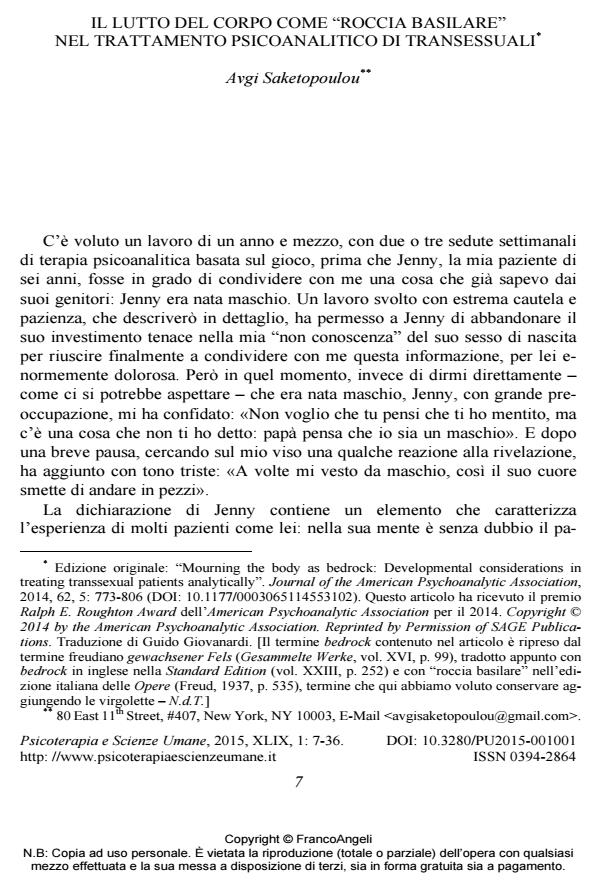Il lutto del corpo come "roccia basilare" nel trattamento psicoanalitico di transessuali
Titolo Rivista PSICOTERAPIA E SCIENZE UMANE
Autori/Curatori Avgi Saketopoulou
Anno di pubblicazione 2015 Fascicolo 2015/1
Lingua Italiano Numero pagine 30 P. 7-36 Dimensione file 346 KB
DOI 10.3280/PU2015-001001
Il DOI è il codice a barre della proprietà intellettuale: per saperne di più
clicca qui
Qui sotto puoi vedere in anteprima la prima pagina di questo articolo.
Se questo articolo ti interessa, lo puoi acquistare (e scaricare in formato pdf) seguendo le facili indicazioni per acquistare il download credit. Acquista Download Credits per scaricare questo Articolo in formato PDF

FrancoAngeli è membro della Publishers International Linking Association, Inc (PILA)associazione indipendente e non profit per facilitare (attraverso i servizi tecnologici implementati da CrossRef.org) l’accesso degli studiosi ai contenuti digitali nelle pubblicazioni professionali e scientifiche
Viene introdotto il concetto di "trauma grave di genere", una sindrome che emerge dall’incontro tra il mancato riconoscimento di genere dei pazienti transessuali e l’esperienza angosciosa del corpo in cui si è nati. Negli ultimi anni, la consapevolezza degli psicoanalisti sulla complessità delle interazioni tra psiche, soma e cultura è progressivamente cresciuta, per cui i rischi psicologici del mancato riconoscimento di genere hanno suscitato un interesse sempre maggiore. Ma la disforia legata al corpo è spesso trascurata anche da quegli analisti che lavorano con l’esperienza di genere. Col resoconto della terapia di una bambina transessuale di cinque anni, nata con un corpo maschile, viene seguito il percorso evolutivo di un corpo non sufficientemente mentalizzato. Mettendo a fuoco le trasformazioni della fantasia inconscia, si mostra quanto per i pazienti transgender sia importante la rappresentazione mentale del dolore originato dal corpo, la quale è una delle condizioni necessarie per una sana transizione transessuale.
Parole chiave:Gender, mancato riconoscimento di genere, disforia rispetto al corpo, fantasia inconscia, transgender
- Trans-narrative psicoanalitiche Andrea Crapanzano, in Ricerca Psicoanalitica /2024
DOI: 10.4081/rp.2024.900 - Corpo e diniego: l'enigma transgender Anna Maria Nicolò, Laura Accetti, in PSICOTERAPIA PSICOANALITICA 1/2022 pp.29
DOI: 10.3280/PSP2022-001003
Avgi Saketopoulou, Il lutto del corpo come "roccia basilare" nel trattamento psicoanalitico di transessuali in "PSICOTERAPIA E SCIENZE UMANE" 1/2015, pp 7-36, DOI: 10.3280/PU2015-001001